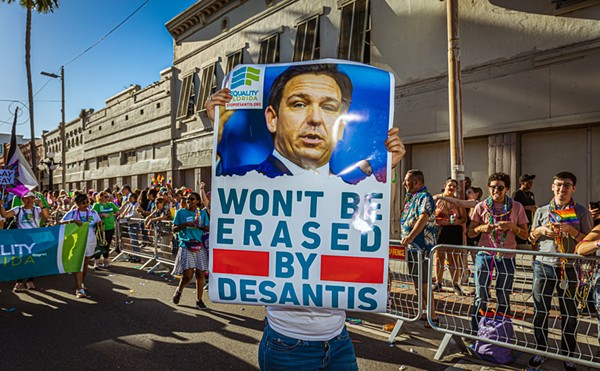My favorite crackpot theory of the week concerns Gina Wendkos, the screenwriter of Disney's new The Princess Diaries.
If Wendkos' name rings any sort of bell, it's most likely because she's also the culprit responsible for penning that grueling punishment known as Coyote Ugly. On an even more obscure note, though, you might find it interesting that Ms. Wendkos is, according to her bio, a bona fide, former performance artist, NEA-funded and the whole nine yards.
On the basis of those little nuggets of information, here's the theory: Gina Wendkos' entire career as a mild-mannered writer of stupid Hollywood pap is merely a ruse. She is, in fact, continuing to live a secret life as a button-pushing, anarchy-baiting performance artist.
What I'm suggesting here is that all of Wendkos' movies thus far, no matter how bland or idiotic they appear to be, might in fact be deceptively sophisticated litmus tests deliberately aimed at making us squirm, and then secretly measuring the pain and boredom threshold of those in the audience.
And if that theory doesn't float your boat, maybe you'll like this one: Let's say that Gina Wendkos, much like Sony's infamous made-up movie critic, doesn't really exist. Let's say "Gina Wendkos" is actually just a front for a collective of sadomasochistic terrorists dedicated to bringing America to its knees by causing us to lose all faith in the motion picture industry that fuels the nation's dreams and commerce.
Either way, the news is not good. If you buy into the first theory, at least — the totally insipid movie as covert performance art — then The Princess Diaries might just strike you as one of the more subversive films you'll see this year.
The film's premise — a springboard for the sort of unlikely plot that movies could barely get away with even in the infinitely more forgiving climate of a half-century ago — concerns an average American teen, Mia (Anne Hathaway), who discovers that her late father was actually the crown prince of a small European country, and that she's now the sole heir to the throne. Part of the movie (a very insignificant part, as it happens) unfolds as a sort of wannabe My Fair Lady, in which the girl's Royal Grandmother (screen icon Julie Andrews) attempts to instill culture, class and confidence into a 10th grader whose greatest ambition, like most kids her age, is to be invisible. Beyond that, the story is simply about ugly duckling/oddball Mia transforming into a swan and finally getting the shallow pretty-boy of her dreams, only to discover that the guy she really wanted was right under her royal nose all the time.
As with most less-than-clever, sensitive or skillful attempts to portray this oft-told transformation story, The Princess Diaries winds up sending a lot of mixed messages, and even some potentially destructive ones (particularly considering the movie's target audience of preteen girls). Several plot points hinge on characters fitting in with their designated peer groups or with the rest of society, but it's never quite clear whether the movie is saying that conforming is good or bad. For that matter, The Princess Diaries is obviously all for its characters (particularly its young females) following their dreams, but those characters are drawn in such flat, superficial ways that it hardly matters where those dreams lead. Becoming the most popular girl in school or a bohemian artist or the absolute ruler of a small foreign country — they're all (unintentionally) depicted as equally shallow, so nothing that happens in the movie winds up having much of an impact.
The worst of it, as with so many teen projects of this kind, is that the so-called transformation of our young protagonist never really amounts to much, thereby robbing the movie of any possibility of dramatic momentum. Mia is initially defined both by her outsider status (she lives in a refurbished firehouse — gasp! — with her painter mom), and by the fact that she's supposed to be ugly, or plain, or at least different (that's never quite clear, either). The entire transformation from geek to goddess basically involves Hathaway ditching her glasses, trimming her distinctive, early Brooke Shields-esque eyebrows, and exchanging her wild, frizzed-out mane for a regulation TV weather girl coiffure. I'm not sure what this says to an audience of impressionable 8-year-old girls but, frankly, I thought the before looked a lot more interesting.
The rest of the movie doesn't fare much better. There are a few standard teen subplots, a couple of semi-respectable moments of bonding between Mia and her grandmother, some tepid slapstick (a state dinner party turns into a food fight) and a whole mess of dumb little bumps in the plot's thoroughly predictable path that could have been resolved in under two minutes had the movie contained even a single character smart enough to acknowledge what was happening.
Playing Mia's kooky best friend (and looking more and more like Agnes Moorehead) is Heather Matarazzo, whose connection with Welcome to the Dollhouse only serves to remind us that movies about high school life don't have to be this tepid. The Princess Diaries was directed by a filmmaker who specializes in this sort of clueless fairy tale — Garry Marshall, Penny's brother and the director of such mainstream mush as the wildly popular Pretty Woman and its less successful twin, Runaway Bride. On the bright side, and for what it's worth, Hathaway really does light up a room when she smiles, and she looks great in a tiara.
Gypsies, Tramps and Thieves
A movie inexplicably and almost universally savaged by critics, Sally Potter's The Man Who Cried has its problems, to be sure, but it's also a richly felt and oddly effective effort, as well as being a veritable feast for the senses.
The movie tells the story of Fegele, a little Jewish girl who flees Russia in search of her father, lands in England — where her name is promptly changed to Suzie — and eventually winds up in Paris, just in time for the Nazi invasion. There she blossoms into a young woman (played by Christina Ricci), dances in a chorus line and develops an obsession for gypsy outcasts, particularly one brooding male with dark, soulful eyes and dirty fingernails (Johnny Depp).
Most of the critical trashing of the film has centered on the movie not seeming believable — and, in fact, it's not. The Man Who Cried (the title is an enigma until the very last scene) isn't meant to be taken as reality; Potter is playing with big elements here — big, wild emotions that verge on romantic camp, big images that delight our eyes, and (to a lesser extent) big ideas — all of which have much more to do with magic (or at least magical realism) than with real life.
Outside the obvious example of Moulin Rouge, I can't think of a movie currently making the rounds that makes better, more creative use of theater, or one more consumed with spectacle and artifice. Sometimes the excessive and symbol-charged style gets the better of Potter's movie (as in the repeated scenes of Depp silently gliding through Paris on his white steed) but, more often than not, it works. The film's characters hail from a potpourri of cultures and are represented through some gorgeously shot and occasionally sublime sequences featuring everything from opera to gypsy music.
The Man Who Cried functions as a political and moral tract as well — this is one more movie in which the world slips inexorably into chaos and several of the ostensibly good characters strike Faustian bargains (with Fascism and worse) — but the movie's real strengths lie elsewhere, primarily as a sort of mystical melodrama. Although it's not quite as striking as her much admired Orlando, The Man Who Cried is a major step up from Potter's unintentionally absurd The Tango Lesson, and it's certainly as sensual and grandly proportioned a romantic tragedy as you'll see this summer.














